#Ledumahadi
Text
Walking in the Elliot Formation
Walking in the Elliot Formation, South Africa and Lesotho in the early Jurassic.
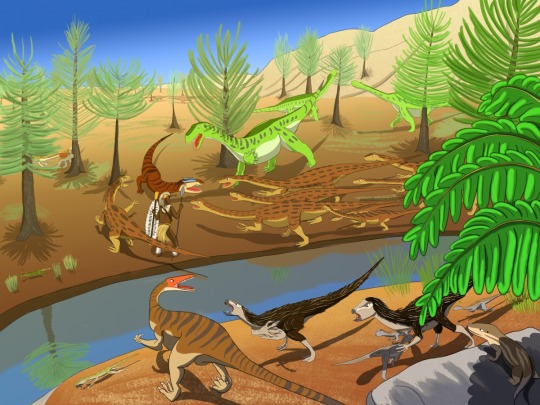
View On WordPress
#adobe photoshop#Africa#African people#artistatwork#Commissions Open#Concept Art#Digital Art#DigitalPainting#dinosaur#Environment Design#Heterodontosaurus#Jurassic#Jurassic Period#landscape#landscape art#Landscape Painting#Ledumahadi#Lesotho#Massospondylus#native people#paleontology#Palo Art#proto-sauropds#South Africa#Wacom Tablet#zulu#zulu tribe#zulu warrior
1 note
·
View note
Text
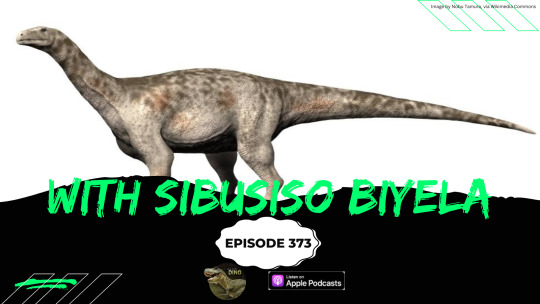
For day 14 of our 8th anniversary celebrations of I Know Dino, meet Sibusiso Biyela, science writer and communicator, and advocate for decolonizing science.
In episode 373, we chatted with him about his project to bring scientific terminology to six African languages, and his article about Ledumahadi in Zulu
You can still listen at https://podcasts.apple.com/us/podcast/a-fossilized-baby-dino-a-new-ankylosaur-and/id960976813?i=1000548457407
2 notes
·
View notes
Text
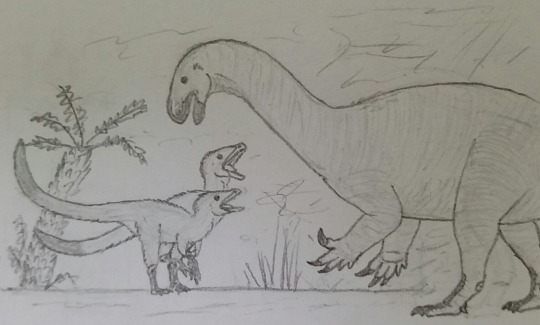
Coelophysis & Ledumahadi
17 notes
·
View notes
Text
Mesozoic Monthly: Ledumahadi
January brings with it a new year and a new installment of Mesozoic Monthly! At the start of a new decade, perhaps the perfect prehistoric creature to honor this month is the dinosaur Ledumahadi mafube, the “giant thunderclap at dawn.”
Ledumahadi was an early sauropodomorph, a group of herbivorous dinosaurs that ultimately produced the famous sauropods. Sauropods such as Brachiosaurus or Diplodocus are popular dinosaurs because of their often monstrous sizes, long necks, and lengthy, sometimes whip-like tails. One of the traits that paleontologists believe helped sauropods get so big was their pillar-like legs. Their legs were straight, like stilts, and heavily constructed so that they could support the weight of the animal. Modern elephants also have columnar legs, similar to those of sauropods, because this style of limb is so efficient for big animals. Non-sauropod sauropodomorphs tended to be smaller than their sauropod cousins, and could walk on either two legs or four. Quadrupedal early sauropodomorphs such as Ledumahadi did not have the columnar legs of sauropods, but instead walked with their forelimbs partially bent.
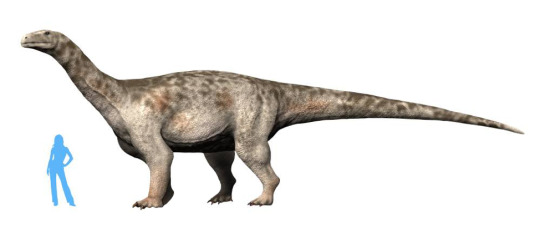
Life reconstruction of Ledumahadi by Nobu Tamura with a human silhouette for scale. This was a big beast! Note how, unlike its sauropod kin, this early sauropodomorph walked with its forelimbs flexed at the elbow. Read the 2018 scientific paper that described it (for free) here.
The largest known dinosaur of its kind, Ledumahadi weighed over 13 tons (12 metric tons), and reconstructions estimate that it grew over 30 feet (9 meters) long! This size is noteworthy, because it shows that it was possible for sauropodomorphs to reach gigantic sizes without columnar legs. This demonstrates that terrestrial animals can get big due to a variety of adaptations. In this case, the tremendous size of both sauropods and Ledumahadi is an example of convergent evolution, a process in which unrelated animals can evolve similar features. One classic example of convergent evolution is wings. Birds, bats, and pterosaurs are unrelated, yet all evolved similar structures that increase surface area for flying. But they all did it in different ways: birds have feathers anchored to the forearm and a fused hand, bats have skin stretched across five fingers, and pterosaurs had skin stretched along one long finger. Although we may not definitively know how Ledumahadi achieved its status as a “great thunderclap,” we do know that it did so along a different evolutionary pathway than its sauropod relatives.
The name Ledumahadi mafube means “great thunderclap at dawn,” referring to the massive size of the animal and its early place in the rock record. Unlike many dinosaur names, it is not derived from Latin or Greek; instead, it is from Southern Sotho, one of the languages spoken in South Africa, where the creature’s fossils were discovered.
Not many well-known animals lived in the Early Jurassic of southern Africa alongside Ledumahadi; the most famous dinosaurs are other sauropodomorphs such as Massospondylus, the small bipedal herbivores Heterodontosaurus and Lesothosaurus, and the small carnivore Coelophysis (formerly called Syntarsus) rhodesiensis. They all lived in an arid floodplain that was crisscrossed by meandering streams. Every so often, after a long period of stability, these water channels would flood, depositing new soil and nutrients and rejuvenating the ecosystem. A great deal of plant growth occurs after floodplains drain, reflecting a cycle of renewal that is familiar to us during each and every new year.
Lindsay Kastroll is a volunteer and paleontology student working in the Section of Vertebrate Paleontology at Carnegie Museum of Natural History. Museum staff, volunteers, and interns are encouraged to blog about their unique experiences and knowledge gained from working at the museum.
#Carnegie Museum of Natural History#Mesozoic Monthly#Ledumahadi#Vertebrate Paleontology#Paleontology
17 notes
·
View notes
Photo
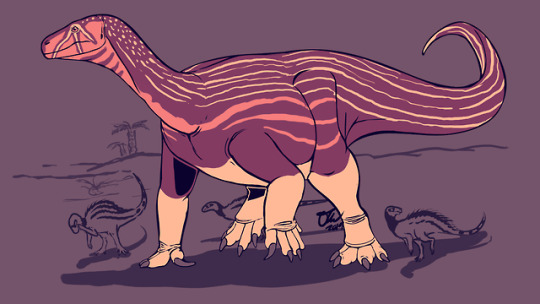
Little late again, but here's the first 2018 dinosaur of my palette challenge: the giant lessemsaurid Ledumahadi in #74, going on a walk with an accompaniment of Heterodontosaurus.
Find the palettes here.
158 notes
·
View notes
Photo
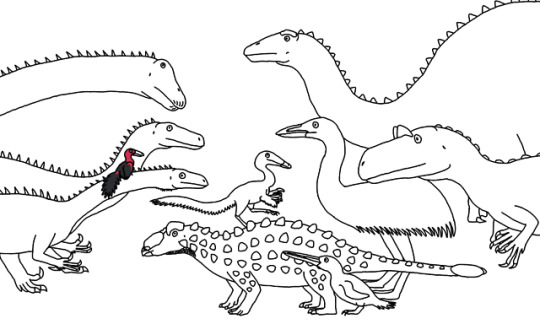
A selection of new dinosaurs named in 2018.
#Dinosaurs#Palaeoblr#2018#Ledumahadi#Caihong#Saltriovenator#Macrocollum#Lavocatisaurus#Jinyunpelta#Bannykus#Sequiwaimanu#Vorombe#Lingwulong
132 notes
·
View notes
Link
“Some 200 million years ago in what's now South Africa, a dinosaur that weighed as much as two adult African elephants loomed over the landscape. This massive herbivore got so big in a peculiar way—and it had a downright bizarre way of standing on all fours.
The new dinosaur, unveiled in Current Biology on Thursday, looks like a sauropod, the group of classic long-necked dinosaurs that includes Brontosaurus, but it's technically not. Instead, Ledumahadi is an earlier, more distant cousin called a sauropodomorph. It is a much bigger animal living much earlier in the age of dinosaurs than researchers normally expect to see, so its discoverers etched their surprise into the dinosaur's name: Ledumahadi mafube, Southern Sotho for “a giant thunderclap [at] dawn.”
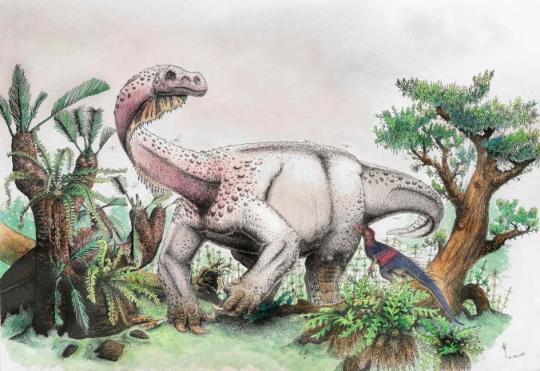
Like elephants, true sauropods had column-like limbs that efficiently supported the animals' weight. But Ledumahadi took a decidedly different approach. It seems to have had a more mobile forelimb, but it stood in a less efficient catlike crouch, with knees and elbows partly flexed.”
#News#Palaeontology#Ledumahadi#Ledumahadi mafube#Sauropodomorph#Dinosaur#Article#Link#Info#Information#Art#Prehistoric#Mesozoic#Triassic#Extinct
104 notes
·
View notes
Photo
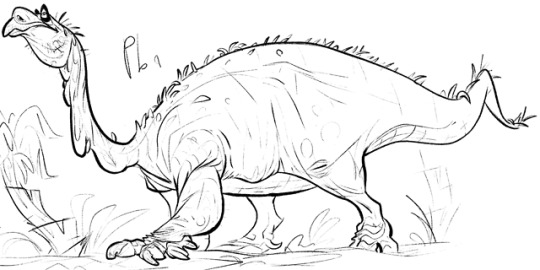
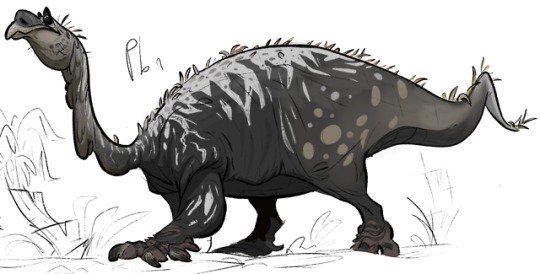
A non colored version because i'm not happy with how the uncolored version turned out :(
22 notes
·
View notes
Photo

Basically my take on Ledumahadi, a large sauropod tat lived in South Africa during the Jurassic period. I heard that it is possible that sauropods may have had feathers covering their body like elephants have tiny hairs so I have fun with that. Despite being large, it may have moved in a catike manner.
1 note
·
View note
Link
0 notes
Note
The Ledumahadi Mafube (who's name means "a giant thunderclap at dawn") seems fitting to base it on bc Petrichor refers to the smell after rain.
I’m looking at pictures and I absolutely adore it. I’m going to start sketching ASAP!!!
1 note
·
View note
Photo

Millions of years before the brontosaurus roamed the Earth, a massive relative was lumbering around South Africa.
Scientists think this early Jurassic dinosaur was the largest land creature ever to have lived. And unlike the even bigger creatures that came later, they think it could pop up on its hind legs.
They've dubbed the newly discovered dinosaur Ledumahadi mafube, which translates in the Sesotho language to "a giant thunderclap at dawn." And the discovery sheds light on how giants like the brontosaurus got so huge.
Bones Reveal The Brontosaurus Had An Older, Massive Cousin In South Africa
Illustration: Viktor Radermacher, University of the Witwatersrand
515 notes
·
View notes
Photo

Day 5: Sauropoda. This is the basal member of the Sauropoda family which is Ledumahadi (meaning “A Thunder Clap”). #sauropoda #inktober #inktober2019 #myart #ledumahadimafube #dinosauria #paleoart #inkdrawing #inkdrawings https://www.instagram.com/p/B3Q1T8YFOWy/?igshid=ohedkpu11mw6
2 notes
·
View notes
Text
Ledumahadi mafube -- South Africa's new jurassic giant
Ledumahadi mafube — South Africa’s new jurassic giant
IMAGE: The Highland Giant: Artist Viktor Radermacher’s reconstuction of what Ledumahadi mafube may have looked like. Another South African dinosaur, Heterodontosaurus tucki, watches in the foreground.
view more
Credit: Copyright Viktor Radermacher
A new species of a giant dinosaur has been found in South Africa’s Free State Province. The plant-eating dinosaur, named Ledumahadi…
View On WordPress
#Africas#Archaeology#Biology#Evolution#Genetics#giant#Jurassic#Ledumahadi#mafube#New World#Old World#paleontology#South#Zoology/Veterinary Science
0 notes
Text
Ledumahadi mafube: South Africa's new jurassic giant
Ledumahadi mafube: South Africa's new jurassic giant
[ad_1]
A new species of a giant dinosaur has been found in South Africa’s Free State Province. The plant-eating dinosaur, named Ledumahadi mafube, weighed 12 tons and stood about four meters high at the hips. Ledumahadi mafube was the largest land animal alive on Earth when it lived, nearly 200 million years ago. It was roughly double the size of a large African elephant.
[ad_2]
Source link
View On WordPress
#Africa039s#Extinction; Animals; Nature; New Species; Dinosaurs; Paleontology; Fossils; Ancient DNA#giant#Jurassic#Ledumahadi#mafube#south
0 notes
Note
Is Ledumahadi the giant Elliot sauropodomorph mentioned by Wedel & Yates at SVP 2011?
Nope. And Wedel and Yates’s presentation was at SVPCA, not SVP.
1 note
·
View note